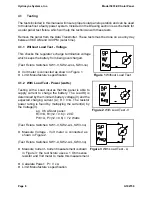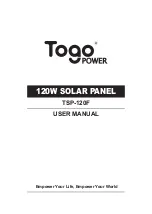
HydroLynx Systems, Inc.
Model 5033-XX Solar Panel
Page 6
A102759
Latitude of Site
Tilt Angle
0 thru 4°
10°
5 thru 20°
Add 5° to local latitude
21 thru 45°
Add 10° to local latitude
46 thru 65°
Add 15° to local latitude
66 thru 75°
80°
2.3 Installation
WARNING
: Solar panels generate electricity when exposed to any light source; electrical
shock and burns can result from direct contact with the panel terminals. Cover the panel
surface with an opaque material before handling the electrical connections to the panel.
Additional hazards exist whenever the panels are wet..
Refer to Manufactures Mounting Bracket Assembly Diagram
!
Attach mounting bracket to solar panel.
!
Power Cable is threaded up the antenna mast and attached to the regulator.
!
Attach mounting bracket to antenna mast, pole or standpipe with hose clamps.
!
Thread power cable with 3-pin connector through standpipe cable port.
!
Install antenna mast onto the standpipe.
!
Align panel to face true south .
!
Tighten clamps.
!
Adjust panel to correct tilt angle.
!
Tighten clamps.
!
Attach the 3-pin connector to the 12 VDC IN port on the Data Transmitter.
Warning:
Never operate the Data Transmitter on solar power only, always connect the
solar panel after the battery is connected;
3.0 THEORY OF OPERATION
3.1 Solar Resource
The intensity of sunlight falling on a surface is called the solar
irradiance
and is commonly
measured in units of
Watts per square meter
(W/m²). Just outside the earth’s atmosphere
a nearly constant
irradiance
of 1360 (W/m²) falls on a flat surface normal (90°) to the sun’s
rays. The earth’s atmosphere reflects and absorbs about 30% of the solar spectrum giving
a full sun
irradiance
of approximately 1000 (W/m²) at the earth’s surface; this value is
called the
peak sunlight
irradiance.
Summary of Contents for 5033-XX
Page 10: ......




























